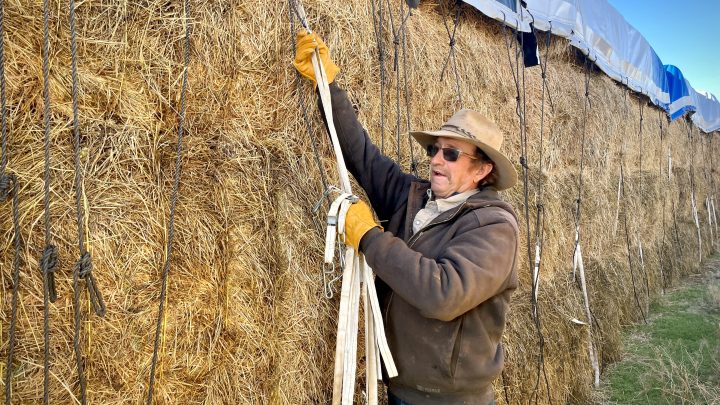
Inflation drives up hay prices, forcing some horse owners to sell
Inflation drives up hay prices, forcing some horse owners to sell

Tom Johnston is a hay producer in western Wyoming who sells his hay to horse owners across the country. He has been doing this since the 1980s.
On a crisp fall morning, Johnston was out working in his hay yard. “I gotta pull this tarp off,” he said. “I got a buyer from Green River,” a nearby town. When he rolled back the tarp on the towering hay stack, it revealed deep, green square hay bales that smell sweet and earthy.
“Yeah, this is nice hay,” he said.
This year, Johnston is charging $325 per ton. He said it’s the most he’s ever charged. For context, a horse will typically eat about two tons of hay over the course of a winter.
It’s is largely inflation that’s affecting Johnston’s prices, he said, and average hay prices across the Rocky Mountain region have skyrocketed.
“Probably $250 a ton and up,” said Brett Moline, the director of governmental and public affairs for the Wyoming Farm Bureau Federation.
Just two years ago, the price of hay was about $150 per ton in the region, according to Moline. Prices are up because the cost to produce hay this year was so high, he added.
“The price of oil drives so many things,” Moline said. “Fuel prices were substantially higher than they were a year ago. But probably the biggest item is fertilizer costs.”
Hay producers need fertilizer like phosphorus and nitrogen to make the crop in bulk, and this year the prices are about double from what they were last year.
Back at the hay yard, Johnston said higher fertilizer costs for him mean higher costs of hay for customers.
“And you know, I feel for my people, because a lot of my customers are 20-year customers. You know, but at the same time, you know, we don’t do it for fun. We like what we do, but we can’t just — we’re a pretty tight little operation,” Johnston said. “We don’t have room to lose a bunch of money.”

Johnston predicted the high prices will not be sustainable. “Oh, hay prices are going to crash pretty hard in another year or so,” he said. “I would say next year they’ll be down quite a bit.”
Johnston said he thinks people will start selling their horses, so demand will go down.
That is actually the case for Spring Moore, who is a working cowgirl in western Wyoming.
“So, this winter I’ve kind of cut down on my number of horses mainly just because of the cost of feeding through the winter,” Moore said.
She’s sold off two horses so far, leaving her with a total of five, which means she now has fewer horses for rodeoing and cowboying. It’s the first time she’s had to do that because of hay prices, she said.
But if you are going to have even one horse in Wyoming, Moore said, hay is a necessity.
“Especially around here, because I mean some places down south, they can feed grass, you know, all year long, but around here we don’t have that option,” she said. “When the snow gets three or four foot deep, we have to feed the hay.”
Having horses is a way of life for Moore. But if prices keep increasing, she said she won’t be able to maintain her herd size.
There’s a lot happening in the world. Through it all, Marketplace is here for you.
You rely on Marketplace to break down the world’s events and tell you how it affects you in a fact-based, approachable way. We rely on your financial support to keep making that possible.
Your donation today powers the independent journalism that you rely on. For just $5/month, you can help sustain Marketplace so we can keep reporting on the things that matter to you.

















